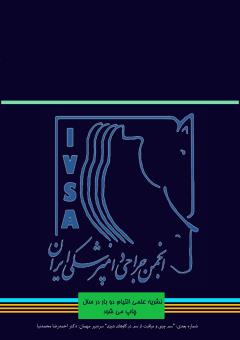Isolation and Determination of Antibiotic Resistance of Salmonella and Staphylococcus Isolated from Dog and Cat Diets
Subject Areas : Other Related SciencesEbrahim Janmohammadi Firooz 1 , Mehdi Sharifi Soltani 2 , Atefeh Bozorgi 3
1 - Graduated Student of Veterinary Medicine, Department of Veterinary Medicine, Faculty of Veterinary Medicine, Islamic Azad University, Babol Branch, Babol, Iran.
2 - Assistant Professor, Department of Veterinary Medicine, Faculty of Agriculture, Islamic Azad University, Chalous Branch, Chalous, Iran.
3 - Assistant Professor, Department of Veterinary Medicine, Faculty of Veterinary Medicine, Islamic Azad University, Babol Branch, Babol, Iran.
Keywords: Antibiotic resistance, Salmonella, Staphylococcus, Dog, Cat.,
Abstract :
Bacterial contamination and widespread use of antibiotics lead to the emergence of antibiotic-resistant bacteria. The aim of this study was to isolate Salmonella and Staphylococcus from diets used for dog and cat and to determine their antibiotic resistance. 50 samples of dog and cat dry diets were collected. For isolation of Salmonella, culture in liquid Selenite-F, Bismuth sulfite, xylose lysine deoxycholate (XLD) and Salmonella Chromogenic agar were used and for the detection of Staphylococcus, Baird-Parker and mannitol-salt agar. Antibiogram testing was performed by disk diffusion method. Data were analyzed using SPSS 16 software, chi-square test and independent t-test (p≤0.05). Salmonella and Staphylococcus infections were 72% and 20% in dog food and 26% and 80% in cat food, respectively. 100% of the dry bulk feed of cats infected with Salmonella and Staphylococcus and 100% of the samples of dry bulk feed of dogs were infected with Salmonella. 100% of Salmonella strains were resistant to all antibiotics. There was a significant relationship between the level of bacterial contamination and the type of diet (p≤0.05). The presence of bacteria along with antibiotic resistance was identified in this study. Hygiene principles and microbial evaluations are necessary to control and prevent food contamination with bacteria.
1. Nemser SM, Doran T, Grabenstein M, McConnell T, McGrath T, Pamboukian R, et al. Investigation of Listeria, Salmonella, and toxigenic Escherichia coli in various pet foods. Foodborne Pathogens and Disease. 2014;11(9):706-709.
2. Feng T, Keller LR, Wang L, Wang Y. Product quality risk perception and decisions: contaminated pet food and lead-painted toys. Risk Analysis. 2010;30 (10):1572–1589.
3. Quinn PJ, Markey BK, Leonard FC, Fitzpatrick ES, Fanning S. Concise review of veterinary microbiology. 2nd Edition, New Delhi, India, 2015;pp: 20-22.
4. Heyse S, Leigh FH, Woolston J, Sulakvelidze A, Charboneau, D. Bacteriophage Cocktail for biocontrol of Salmonella in dried pet food. Journal of Food Protection. 2015;78 (1): 97-103.
5. Morris DO, Mauldin EA, O'Shea K, Shofer FS, Rankin SC. Clinical, microbiological, and molecular characterization of methicillin-resistant Staphylococcus aureus infections of cats. American Journal of Veterinary Research. 2006;67(8):1421-1425.
6. Kim MK, Yoon HY, Lee MH, Kim JH. Canine pyometra associated with Bacillus species: a case report. Veterinarni Medicina. 2018;63(03):143–149.
7. Soltan Dallal MM, Rahimi Forushani A, Sadigh Maroufi S, Sharifi Yazdi K. The comparison of PCR technique and API-20E kit with the conventional biomedical methods for the identification of Salmonella species in laboratory. Medical Laboratory Journal. 2011;5 (2):20-27.
8. Amini K, Nasr H, Kheykhah B. Molecular detection of Salmonella bacteria isolated by PCR from ostriches samples in Sirjan district of Kerman province. New Cellular and Molecular Biotechnology Journal. 2018;9(33):31-38.
9. Khoori E, Ataye Salehi A, Khoori M. Determination of antibiotic resistance pattern of methicillin-resistant Staphylococcus aureus isolated from the food samples by multiplex PCR. Journal of Food Microbiology. 2018;4(4):21-30.
10. Ranazanzadeh R, Moradi G, Zandi S, Mohammadi S., Rouhi, S, Pourzare, M, et al. A survey of contamination rate and antibiotic resistant of Gram-negative bacteria isolated from patients in various wards of Toohid and Besat Hospitals of Sanandaj city during 2013-2014 years. Pajouhan Scientific Journal. 2016;14(3):11-19.
11. Clinical and Laboratory Standards Institute (CLSI). Performance Standards for Antimicrobial Susceptibility Testing. 27th Edition. CLSI supplement M100. 2018;pp: 32-39 and 56-63.
12. Burt S. Essentialoils: their antibacterial propertied and potential application in foods-a review. International Food Mashinicrobiology. 2004;94(3):223-253.
13. Lambertini E, Buchanan RL, Narrod C, Pradhan AK. Transmission of bacterial zoonotic pathogens between pets and humans: the role of pet food. Critical Reviews in Food Science and Nutrition. 2016;56(3):364-418.
14. Awosile BB, McClure JT, Saab ME, Heider LC. Antimicrobial resistance in bacteria isolated from cats and dogs from the Atlantic Provinces, Canada from 1994-2013. Canadian Veterinary Journal. 2018;59(8):885-893
15. Taheri Mirghaed A, Yunesian M, Dargahi H, Bahonar A, Bahrami A, Lalehgani A, et al. The relationship between contact with pets and domestic animals and their owners’ mental health and personality trait. Payavard Salamat. 2013;7(1): 21-31.
16. Oni RA, Lambertini E, Buchanan RL. Assessing the potential for Salmonella growth in rehydrated dry dog food. Food Contamination. 2016;20 (2016): 3.
17. Olatunde GA, Atungulu GG. Chapter 3 - emerging pet food drying and storage strategies to maintain safety. Food and Feed Safety Systems and Analysis. 2018;pp: 45-61.
18. Mir R, Rashki Ghalehnoo Z. Frequency and antimicrobial resistance pattern of salmonella spp in asymptomatic rural dog in Zabol. New Findings in Veterinary Microbiology. 2018;1(1): 44-50.
19. Stogdale, L. One veterinarian's experience with owners who are feeding raw meat to their pets. Canadian Veterinary Journal. 2019;60(6):655-658.
20. Strohmeyer RA, Morley PS, Hyatt DR, Dargatz DA, Scorza AV, Lappin MR. Evaluation of bacterial and protozoal contamination of commercially available raw meat diets for dogs. Journal of the American Veterinary Medical Association. 2016;228(4):537-542.


